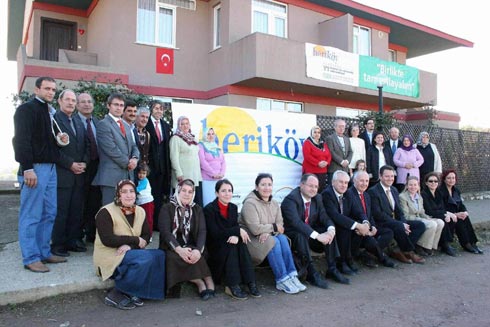Dream village (Berikoy) rising in wake of quake
- Ayrıntılar
- Üst Kategori: ROOT
- Kategori: Habitat News
Robert J. Sales, News Office

The dream of a safe new Turkish community, hatched in the wake of an earthquake that killed at least 15,000 and destroyed dozens of towns and villages, is becoming a reality for 50 displaced families this summer.
Thanks to the skill and tenacity of MIT Professor Jan Wampler of architecture and two MIT graduates who live in Turkey, ground was broken last month for an innovative housing project near the city of Adapazari that will provide homes for the 50 families. Their homes were destroyed by the 1999 quake that measured 7.4 on the Richter scale. They have been living in tents and prefabricated housing for almost four years.
Wampler and his former students, Rukiye Devres Unver and Barbara Brady, and students from his international workshop course toured the area after the quake, surveying the damage and talking with victims. As a result of those discussions, they compiled a list of residents' desires for their rebuilt community.
The microvillage, called Berikoy, was designed in a workshop conducted by Wampler and eight MIT undergraduates and graduate students, who followed the families' wish list.
Their design replaces the concrete apartment complexes that buckled during the quake with one- and two-story homes with gardens. The plans called for community centers, a library, a computer center and tasteful landscaping.
The houses are being constructed on a hill with foundations in underground rock, not on the loose topsoil that crumbled beneath the previous units. The frameworks will be galvanized steel, while walls and roofs will be made from local materials.
Solar panels and windmills will provide power and heat. Reservoirs will be filled with rainwater. Sewage will be treated for use as fertilizer.
The microvillage will be run as a cooperative, with collective ownership of the community centers and individually owned housing units. Families will be required to participate in training courses to learn about cooperative principles, organization function and member obligations.
The residents, who have average family incomes of less than $400 a month, will pay less than $100 a month on a mortgage for quake-resistant two- and three-bedroom units that measure 700 to 900 square feet. Each family must pay for materials and donate 500 hours of labor. That commitment may be fulfilled by doing carpentry and construction work, cooking or child care, or providing other services for workers.
Enes Karaca, 7, and his sister Zeynep, 4, lined up for work details on the first day of construction. "I can carry boxes which are not heavy," said Enes. "I can give nails to people working with hammers." Zeynep added, "I can do cleaning." Actually, the workers must be 18 or older.
The $1.5 million project is supported by Habitat for Humanity and the Turkish foundation CEKUL.
"This village represents a new way of thinking about living, and you are pioneers in this bold new idea," Wampler told the 50 families at the June 6 groundbreaking. Speaking in Turkish, he concluded by saying, "I wish you the best on this beautiful hill that will become your home. I also wish you peace in your home and in your country, and for all of us, peace in the world."
MIT students involved in the design were Bianca Maria Nardella, Steven Jackson, Alexandra Jacobson, Bruno Miller, Lucy Fang, Minna Ha, Monique Lo and Hector Martell.









